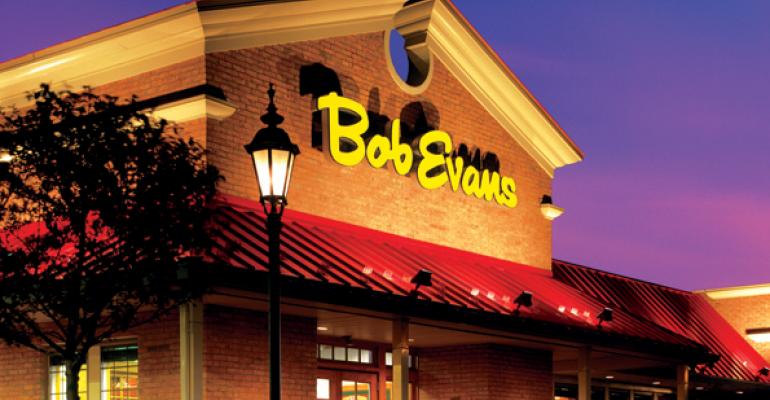Analysts and investors sharply criticized Bob Evans Farms Inc. on Wednesday, after the company released a third-quarter earnings report that included higher food and labor costs and a steeply reduced earnings projection for the year.
Bob Evans’ stock fell more than 20 percent on Wednesday, following a pair of downgrades from Janney Capital Markets analyst Mark Kalinowski and Miller Tabak + Co. analyst Stephen Anderson. Both analysts downgraded Bob Evans from “buy” to “neutral.”
“We are not without challenges as we turn around our business,” Mark Hood, Bob Evans chief financial officer, said during an earnings call on Wednesday. Hood added that the company is “acting with urgency to implement needed changes in the quarters ahead.”
Hood is working alongside Mike Townsley, president of the packaged foods division BEF Foods Inc., as interim co-CEO while the company searches for a replacement to Steve Davis, who stepped down as CEO in December.
Bob Evans’ same-store restaurant sales increased 3.8 percent during the third quarter ended Jan. 23, which was in line with the performance of other family-dining chains during the quarter.
But Bob Evans Restaurants reported an operating loss of $2 million for the quarter, falling from an operating income of $6.6 million in the same quarter a year ago. The company attributed the loss to higher food and labor costs.
As a result, the company lowered its earnings per share estimate for the full year by half a cent, to $1.40 to $1.60 a share, from $1.90 to $2.10 a share.
“At best, same-store sales trends have improved, but few investors are likely to care given the much larger cost issues,” Kalinowski wrote in his note this morning, which he titled “Apocalypse Now.”
Brian Bittner, analyst at Oppenheimer, criticized the company during the earnings call, suggesting that the cost problems came “at a time when you’d expect the company to be maniacally focused on restaurant operations and execution.”
Much of the problem on the cost side appears to be rooted in where the company’s sales are headed. Bob Evans’ off-premise sales have been growing at a much faster rate than its in-store sales, and now represent 21.3 percent of its total business. Yet the operator’s labor model is built around a primarily dine-in model.
Wages and benefit costs as a percentage of sales rose to 39.3 percent during the quarter, from 38.4 percent. And cost of sales, including food and other costs, rose as a percentage of sales to 27.6 percent, from 26.1 percent the previous year.
The company is taking numerous steps to improve operations and ease profit pressures in its restaurants. “We determined that a number of past strategies and tactics are no longer effective,” Hood said.
Changes include ending the chain’s discounting strategy, eliminating buy-one-get-one-free deals and replacing them with buy-one-get-one-50-percent-off offers, when the company wants to build traffic and customer trial.
Revising the menu
(Continued from page 1)
The company is also working on changing Bob Evans’ physical menu to give breakfast and other higher margin items better billing. Executives said they would “more aggressively remove slower selling items.”
In addition, the chain is planning to restructure its general manager program to give those employees an ownership mentality in an attempt to attract and retain quality talent.
Still, investor and analyst reactions suggest disaffection with the current state of the company’s turnaround. There was some excitement behind the brand following the August proxy election that saw four people nominated by activist Sandell Asset Management elected to the board. Entering today, the stock had risen 23 percent since that proxy. The drop Wednesday wiped out that gain and more.
Instead, Bob Evans has reported weakening profits. The company is analyzing its real estate options, but is no longer considering selling BEF Foods, which Sandell had pushed. The company said on Tuesday that the consulting firm Lazard indicated that the division would not likely fetch enough in a sale to make the deal worthwhile to shareholders.
“We think the biggest negative coming out of yesterday’s news was the removal of the sale possibility for BEF Foods, which in our view removes a key catalyst for [Bob Evans],” Anderson wrote in a note Wednesday. He suggested that management could have made a stronger case for selling the division, noting that food companies are currently selling for high multiples at the moment.
But Anderson also noted that this might not mean the end of the prospect of a sale of that division. A new CEO can always revive those discussions, he wrote.
Executives said they planned to cut $35 million in annual general and administrative spending, but they noted it could take some time for those efforts to show in the company’s earnings. The cost cuts will take three years, and came at the recommendation of the consulting firm Deloitte.
Executives also suggested that other cost cuts could come, too. “Everything is under review as we execute a turnaround,” Hood said.
Contact Jonathan Maze at [email protected].
Follow him on Twitter: @jonathanmaze





